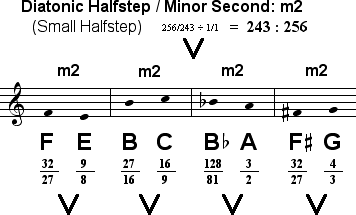 and F
and F
 are included in the system.
are included in the system.Two diatonic halfsteps from B to C and from E to F are already included in the
system of seven naturals. These intervals are also known as minor seconds, and may
be used as upward or downward leading tones. Two additional diatonic halfsteps are
available when B and F
and F
 are included in the system.
are included in the system.

Diatonic halfsteps are always notated on adjacent staff positions. Change of position and letter makes these intervals diatonic, or moving through the tones. Diatonic halfsteps may also be called small halfsteps.
The term chromatic comes from the Greek word for color. Chromatic halfsteps
are always notated on the same staff position, so the letter does not change; rather, there
is a change of accidental. Because accidentals are not used in the system of diatonic
naturals, chromatic halfsteps are not diatonic. The terms chromatic and
diatonic are thus antonyms. The addition of B and F
and F to our system results in two chromatic
halfsteps. The chromatic halfstep may also be called the large halfstep.
to our system results in two chromatic
halfsteps. The chromatic halfstep may also be called the large halfstep.

Next, we explore how the system may be expanded to include more diatonic and chromatic halfsteps through use of additional flats and sharps.
NEXT: From 7 to 13 Tones